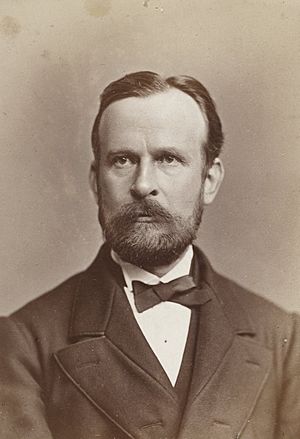Ferdinand von Richthofen facts for kids
Quick facts for kids
Ferdinand von Richthofen
|
|
|---|---|
 |
|
| Born | 5 May 1833 Carlsruhe, Prussian Silesia
|
| Died | 6 October 1905 (aged 72) |
| Nationality | German |
| Alma mater | University of Breslau University of Berlin |
| Awards | Wollaston Medal (1892) Vega Medal (1903) |
| Scientific career | |
| Fields | Geography |
| Institutions | University of Bonn University of Leipzig University of Berlin |
| Doctoral students | Sven Hedin Alfred Philippson Arthur Berson Wilhelm Sievers |
| Signature | |
Ferdinand von Richthofen (born May 5, 1833 – died October 6, 1905) was a famous German traveler, geographer, and scientist. Many people knew him as Baron von Richthofen. He is well-known for creating the terms "Seidenstraße" and "Seidenstraßen" in 1877. These terms mean "Silk Road" or "Silk Routes." He also helped make chorography (mapping regions) and chorology (studying how things are spread out) standard practices. Interestingly, he was the uncle of Manfred von Richthofen, a famous pilot from World War I known as the "Red Baron".
Contents
Life and Discoveries
Early Life and Education
Ferdinand von Richthofen was born in a place called Pokój. Back then, it was known as Carlsruhe in Prussian Silesia. He went to school at the Roman Catholic Gymnasium in Breslau.
He studied medicine at the University of Breslau and the Humboldt University of Berlin. During his studies, he traveled and explored the Alps in Tyrol. He also visited the Carpathians in Transylvania.
Travels and Explorations
In 1860, Richthofen joined the Eulenburg Expedition. This was a Prussian trip that visited many places. They traveled to Ceylon, Japan, Taiwan, and Celebes. They also went to Java, the Philippines, Siam, and Burma. This journey lasted from 1860 to 1862. Sadly, many of Richthofen's notes and collections from this trip were lost.
At that time, China was hard to visit because of the Taiping rebellion. But Richthofen really wanted to explore it. From 1862 to 1868, he worked as a geologist in the United States. He even found goldfields in California.
After his time in the US, he finally got to explore China. He made several trips there. He also visited Japan, Burma, and Java. In China, he found the dried-up lake bed of Lopnur.
Important Writings
Richthofen wrote about his findings in a big work called China: Ergebnisse eigener Reisen und darauf gegründeter Studien. This work was published in Berlin between 1877 and 1885. It had three volumes and an atlas.
In this important book, he wrote about geology and many other topics. He covered everything needed for a complete geographical study. He paid close attention to the natural resources of the areas he visited. He also wrote helpful letters to the Shanghai Chamber of Commerce. He was the first to point out how important the coalfields of Shandong were. He also highlighted the port of Kiaochow.
Teaching and Influence
In 1875, Richthofen became a professor of geology at the University of Bonn. However, he was still busy with his work in China. So, he didn't start teaching until 1879.
In 1883, he became a professor of geography at the University of Leipzig. Then, in 1886, he moved to the Friedrich Wilhelm University of Berlin. He taught there until he passed away. Many students came to his lectures. Many of them later became famous geographers.
To stay in touch with his students, he started a weekly geography meeting. One of his most famous students was Sven Hedin, a Swedish explorer. Richthofen was also the president of the German Geographical Society for many years. He also started the Berlin Hydrographical Institute.
The Silk Road Name
Ferdinand von Richthofen is famous for creating the terms "Seidenstraße" and "Seidenstraßen" in 1877. These German words mean "Silk Road" or "Silk Routes." He also helped make chorography (mapping regions) and chorology (studying how things are spread out) standard practices.
He passed away in 1905 in Berlin.
Interesting Stories
When another explorer named William Gill asked him for advice about a trip to China, Richthofen was very helpful. Gill said that Richthofen spent hours sharing his knowledge.
Gill also said that Richthofen was amazing at putting together small details. He could take many pieces of information and turn them into a clear, complete picture. Gill felt that every tip Richthofen gave him was valuable. He also remembered Richthofen's kindness and smart conversations.
Places Named After Him
A mountain range in western China was named Richthofen Range after him. This range is on the southern edge of the Hexi Corridor. Today, it is known as the Qilian Mountains.
Also, Mount Richthofen in Rocky Mountain National Park is named after him. This mountain is 12,940 feet tall.
See also
 In Spanish: Ferdinand von Richthofen para niños
In Spanish: Ferdinand von Richthofen para niños

